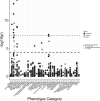Genetically proxied therapeutic prolyl-hydroxylase inhibition and cardiovascular risk
- PMID: 36048866
- PMCID: PMC9851745
- DOI: 10.1093/hmg/ddac215
Genetically proxied therapeutic prolyl-hydroxylase inhibition and cardiovascular risk
Abstract
Prolyl hydroxylase (PHD) inhibitors are in clinical development for anaemia in chronic kidney disease. Epidemiological studies have reported conflicting results regarding safety of long-term therapeutic haemoglobin (Hgb) rises through PHD inhibition on risk of cardiovascular disease. Genetic variation in genes encoding PHDs can be used as partial proxies to investigate the potential effects of long-term Hgb rises. We used Mendelian randomization to investigate the effect of long-term Hgb level rises through genetically proxied PHD inhibition on coronary artery disease (CAD: 60 801 cases; 123 504 controls), myocardial infarction (MI: 42 561 cases; 123 504 controls) or stroke (40 585 cases; 406 111 controls). To further characterize long-term effects of Hgb level rises, we performed a phenome-wide association study (PheWAS) in up to 451 099 UK Biobank individuals. Genetically proxied therapeutic PHD inhibition, equivalent to a 1.00 g/dl increase in Hgb levels, was not associated (at P < 0.05) with increased odds of CAD; odd ratio (OR) [95% confidence intervals (CI)] = 1.06 (0.84, 1.35), MI [OR (95% CI) = 1.02 (0.79, 1.33)] or stroke [OR (95% CI) = 0.91 (0.66, 1.24)]. PheWAS revealed associations with blood related phenotypes consistent with EGLN's role, relevant kidney- and liver-related biomarkers like estimated glomerular filtration rate and microalbuminuria, and non-alcoholic fatty liver disease (Bonferroni-adjusted P < 5.42E-05) but these were not clinically meaningful. These findings suggest that long-term alterations in Hgb through PHD inhibition are unlikely to substantially increase cardiovascular disease risk; using large disease genome-wide association study data, we could exclude ORs of 1.35 for cardiovascular risk with a 1.00 g/dl increase in Hgb.
© The Author(s) 2022. Published by Oxford University Press.
Figures


References
-
- Shafi, T. and Coresh, J. (2019) 1 - Chronic kidney disease: definition, epidemiology, cost, and outcomes. In Himmelfarb, J. and Ikizler, T.A. (eds), Chronic Kidney Disease, Dialysis, and Transplantation, 4th edn. Elsevier, Philadelphia, pp. 2–22.
-
- Levey, A.S. (2022) Defining AKD: the spectrum of AKI, AKD, and CKD. Nephron. 146, 302–305. - PubMed
Publication types
MeSH terms
Substances
Grants and funding
LinkOut - more resources
Full Text Sources
Medical
Miscellaneous

